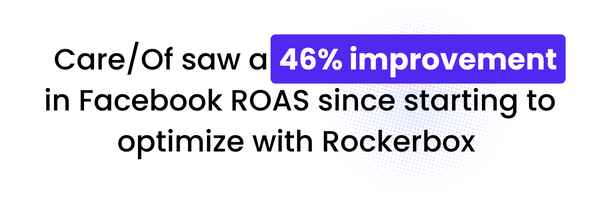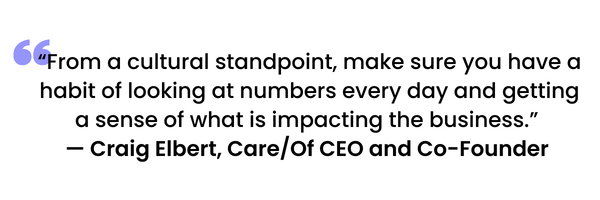Meet Craig Elbert from Care/Of
Craig Elbert, CEO and Co-Founder of Care/Of, has years of business analytics and executive-level marketing experience. In 2016, Craig leveraged his personal passion for health and wellness to create a new, more transparent way to purchase supplements. Care/Of was created to provide a sustainable, honest, and personalized approach in an industry that’s often shrouded in mystery. Elbert and his team have successfully scaled Care/Of to reach hundreds of thousands of consumers and to attain a retail presence in Target stores.
Why Care/Of Partnered with Rockerbox
Craig has led the Care/Of brand through every phase of growth, from startup to scale. Much of the brand’s success can be attributed to a diversified marketing mix, a thriving data org, and accurate internal measurements for visibility at each new stage of growth.
Once the company reached a growth inflection point, Rockerbox allowed Care/Of to gain a holistic view of marketing efforts. This included accessing better insights into paid and organic search, faster and better budgeting, in-depth optimization, and improved customer insights.
Despite DTC triumphs, Craig is careful in his approach to new and startup businesses. Although leaders can get caught up in the excitement of advertising options, Craig has a counter-cultural approach that helps focus and streamline early goals.
“Early on, stay close to the business. Avoid the temptation to overly optimize and expand into all these other channels. Focus on building confidence.”
How Care/Of Benefits from Rockerbox Data
Overall, Rockerbox helps Care/Of dial in on which channels are most effective and which aren’t. With Rockerbox, Care/Of:
- Eliminated whitelisted influencer retargeting on Facebook after finding these to be non-incremental touchpoints that overlapped heavily with other retargeting tactics.
- Scaled hard-to-track channels like influencers and podcasts (33% of marketing spend) with more robust measurement after seeing strong performance compared to digital channels.
- Saw a 46% improvement in Facebook ROAS since starting to optimize using Rockerbox de-duplicated ROAS metrics for campaign, ad set, and ad level optimizations.

Craig also shared in the presentation how one of the most important things that brands can do in the beginning of their journey is to figure out their own story and hook. Unique selling points build brand stability and create traction for future growth. Even though an analytical thinker might want to start optimizing channels immediately, those steps (while important) must come later.
In the long-term, the question becomes focused on how decision-makers can build an analytically-driven, holistic marketing organization.
Early Stage Brands
Establishing a strong foundation and data setup is easy in the beginning, but the process becomes messy and chaotic the longer a brand waits. Smart brands are proactive about how marketers can gather, analyze, and act on data. Investing in a platform like Rockerbox simplifies this process even more.
“From a cultural standpoint, make sure you have a habit of looking at numbers every day and getting a sense of what is impacting the business.”
Craig recommends starting with organic and going into paid channels as the brand evolves. Scale a current spend level, and then get to a point of diminishing return. To do this successfully, brands must have an underlying data foundation and analytics system in place.

Growth Stage Brands
If the first phase of DTC branding is traction, that next phase is scalability. At that critical inflection point, brands should start adding channels, with Facebook and Google being some of the most common.
A team culture must be purposeful about the hard numbers. As growth marketers and agencies come on board, those parties should know that they’ll be accountable to specific questions. While it doesn’t need to be overly complex, marketing teams should also de-duplicate transactions.
Getting the culture right (by pushing and asking questions) is invaluable for knowing what is and isn’t working. A siloed attribution model is one that only uses data from channels individually and has channel managers competing for daily allocation. In contrast, the better option is to have more sophistication on the attribution standpoint, because that data comes from an objective third-party data source. It’s not the platforms trying to take credit.
The other part of major growth is knowing where to pull back (particularly in a downward market), and witnessing improved efficiency and spending at specific levels. This is the stage where optimization is extremely important and quantifiable.
“If you’re spending at levels where small changes will create large impacts, that’s where you want the analysis and testing.”
Results depend on where a DTC brand is on the growth spectrum, with some brands needing to re-budget and pull back. Culturally, this means getting people to shift from the mindset of throwing money at huge channels to investing back in the basics.
Eliminating “Noise”
The key to building an analytically driven marketing organization is knowing how to eliminate extra “noise.” Many brands jump and turn on too many channels at once, thinking it’s the most efficient way to increase return. Contrary to this approach, Craig recommends the opposite. “Be smart about not trying to add too much at once,” he says.
“Once you turn on all these different channels, you really risk so much noise that you can’t tell what’s actually driving things.”
It’s at this point that DTC brands must go through the exercise of pulling things back. Optimization becomes vital to growth, and that process may include dialing back a previous high-performing channel.
What Does the Future Look Like?
For a future-focused brand like Care/Of, Craig recommends having greater sophistication on the attribution model. The other aspect is knowing where to pull back, consolidate, and optimize, particularly in light of current economic trends.
In recent years, Care/Of has taken steps to hire a Chief Revenue Officer to look holistically at acquisition and retention. Understanding the data collectively can help a brand understand what is truly driving revenue numbers, even with a mixed sales channel.
For Care/Of, this diversification looks like establishing a retail presence, understanding acquisition (as it applies to sustainability of the business), and delivering customer value.
Start Optimizing with Rockerbox
At Rockerbox, we help you establish a strong foundation through any stage of brand growth. From startup to scale, Rockerbox attribution models empower you to spend smarter at every twist and turn.
 Google
Google Facebook
Facebook Instagram
Instagram TikTok
TikTok Snapchat
Snapchat Reddit
Reddit Pinterest
Pinterest


.png?width=50&height=56&name=medal%20(1).png)








